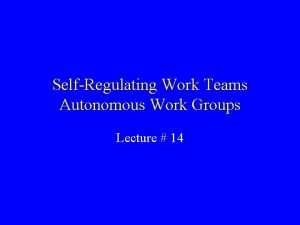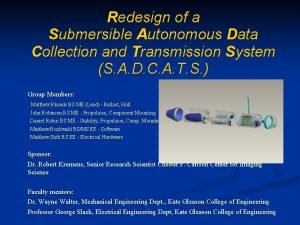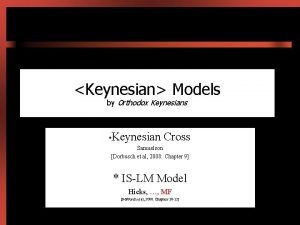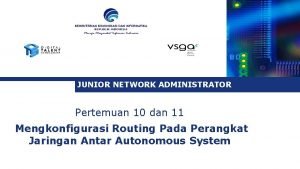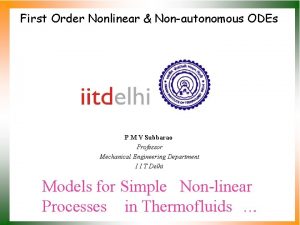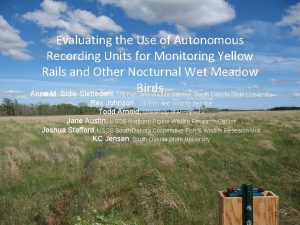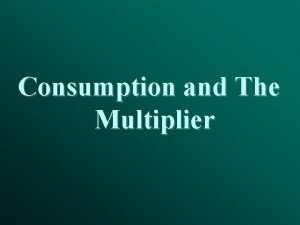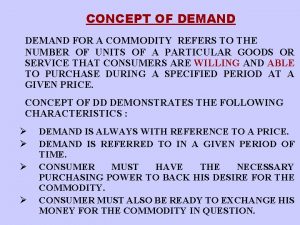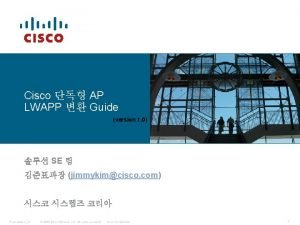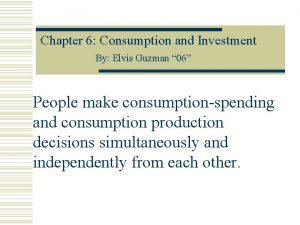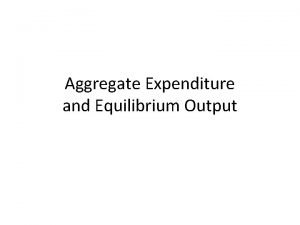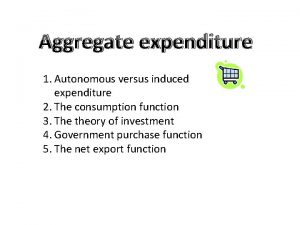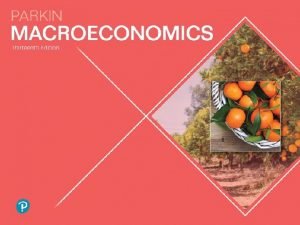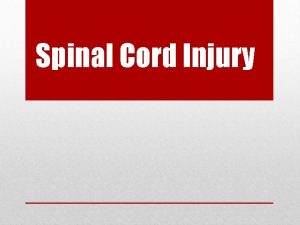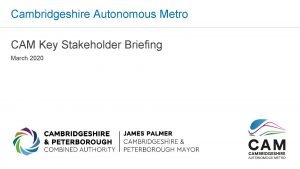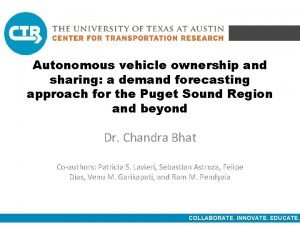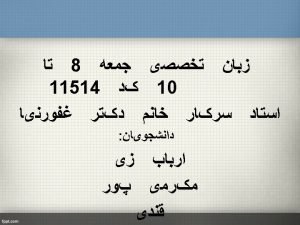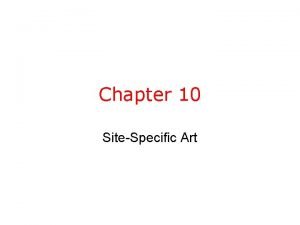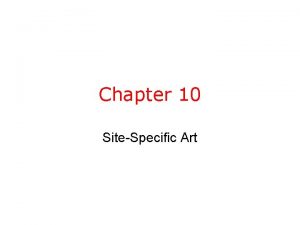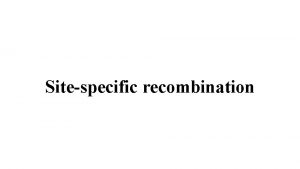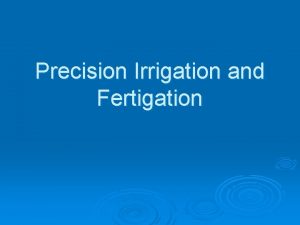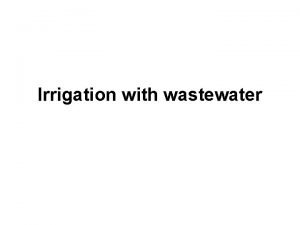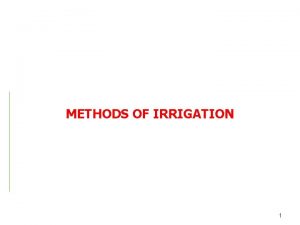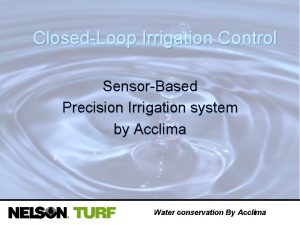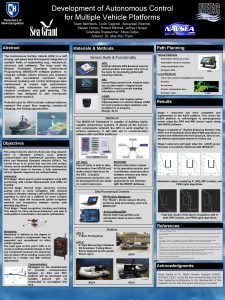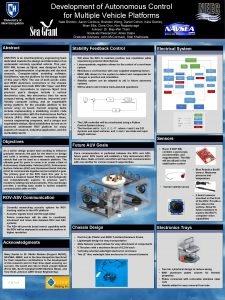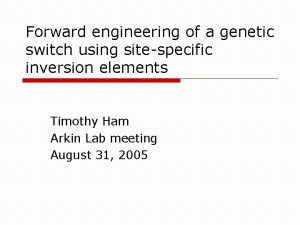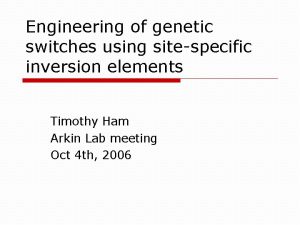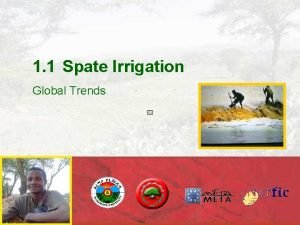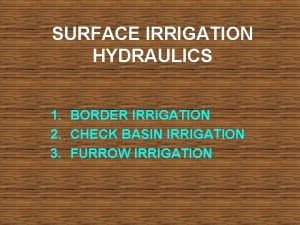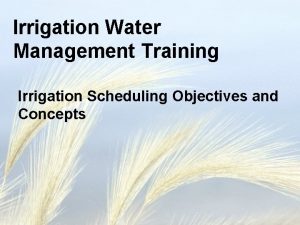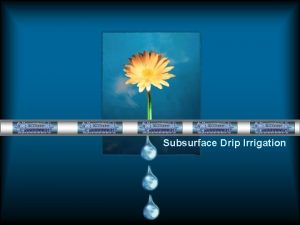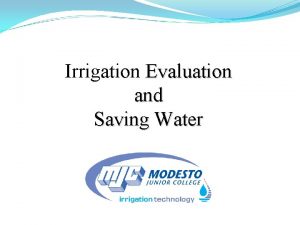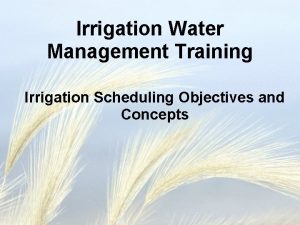Autonomous sitespecific irrigation control engineering a future irrigation
































- Slides: 32

Autonomous site-specific irrigation control: engineering a future irrigation management system Dr Alison Mc. Carthy, Professor Rod Smith and Dr Malcolm Gillies National Centre for Engineering in Agriculture Institute for Agriculture and the Environment mccarthy@usq. edu. au

NCEA’s irrigation research n Water storage and distribution n Infield application n Monitoring tools n Technology support

Cotton irrigation in Australia n Cotton industry accounts for >20% of irrigation water used in Australia n Site-specific irrigation automation presents opportunities for improved water use efficiencies

Need for automation in surface irrigation n Surface irrigation is common in Australia n Furrow – cotton, grains, sugar n Bay/Border – pasture n Labour cost and labour shortage n Siphons started manually n Cut-off time determined manually

Surface irrigation automation hardware n Automation is often time based and inflexible n Currently lacks ability to adapt to field conditions n Rubicon automation hardware and software: (already in commercial use in Dairy Industry)

Variable-rate technology for LMIMs Farmscan n User-defined prescription maps n Four out of 100 growers in Georgia with variable-rate Farmscan systems are still used n Poor irrigation prescription support

Irrigation automation research n Automation enables high resolution data capture and analysis and control Ø Hydraulic optimisation Ø Real-time adaptive irrigation control Ø On-the-go plant and soil sensing technology § Internet-enabled sensing and control integrated into the irrigation system

Surface irrigation hydraulic optimisation n Real-time optimisation of surface irrigation using ‘Auto. Furrow’ n Real-time optimisation typically involves: 1. Inflow measurement 2. Time for advance front to about midway down the field 3. Real-time estimation cut-off time that will give maximum performance for that irrigation

Real-time adaptive irrigation control n Control methodology developed that can adapt to different irrigation systems and crops Actuation Sensors Control strategy

VARIwise control framework n Use sensed data to determine irrigation application/timing n ‘VARIwise’ simulates and develops irrigation control strategies at spatial resolution to 1 m 2 and any temporal resolution n Control strategies based on difference between measured and desired performance

Irrigation control system - strategies Surface irrigation system 1. Sensors Overhead irrigation system 2. Control strategy 3. Real-time irrigation adjustment

Simulation of irrigation management

Simulation of fodder production B Treatment Irrigate all field (A) Irrigate only non-waste areas (B) Irrigate according to EM 38 variability (C) C Water use (ML/ha) 4. 24 ± 0. 00 Biomass yield (kg/ha) 8486. 2 ± 242. 5 3. 76 ± 0. 00 8486. 2 ± 242. 5 3. 04 ± 0. 26 8540. 3 ± 41. 7

Adaptive control strategies n Iterative Learning Control (ILC): n Uses the error between the measured and desired soil moisture deficit after the previous irrigation, n. . . to adjust the irrigation volume of the next irrigation event. n ‘Learns’ from history of prior error signals to make better adjustments. n Iterative Hill Climbing Control (IHCC): n Tests different irrigation volumes in ‘test cells’ to determine which volume produced desired response n Model predictive control (MPC) n A calibrated crop model simulates and predicts the next required irrigation, i. e. volumes and timings Ø according to evolving crop/soil/weather input Ø separately for all cells/zones Ø can choose alternative end-of-season predicted targets

How much infield data is needed? n Iterative Learning Control (ILC) – best where data is sparse n Model Predictive Control (MPC) – needs intensive data set to maximise yields

Irrigation control system - sensors Surface irrigation system 1. Sensors Overhead irrigation system 2. Control strategy 3. Real-time irrigation adjustment

Plant sensing platforms Ground-based platform for surface irrigation Vehicle-based platform for surface irrigation Overhead-mounted platform for centre pivots/lateral moves

Soil-water variability sensing n Estimated by correlating electrical conductivity and infield soil-water sensors

Advance rate sensing using cameras Image from 8 m high tower: Image from 20 m tower:

Irrigation control system - actuation Surface irrigation system 1. Sensors Overhead irrigation system 2. Control strategy 3. Real-time irrigation adjustment

Adaptive control of surface irrigation n Accurate hydraulic models are available to determine irrigation application distributions n Link hydraulic model to a crop production and soil model and control strategy: Ø Crop model estimates crop response to different irrigation applications Ø Control strategy determines irrigation applications Ø Hydraulic model determines spatial distribution of irrigation

Surface irrigation adaptive control trial n Controlled flow rate to achieve irrigation depths along furrow

Advance rate monitoring n Real-time optimisation of flow rate from advance rate Before adjustment: After adjustment:

Surface irrigation trial

Irrigation control system - actuation Surface irrigation system 1. Sensors Overhead irrigation system 2. Control strategy 3. Real-time irrigation adjustment

Adaptive control of centre pivot irrigation n Three replicates of MPC, ILC and FAO -56 with different targets and data inputs (weather, soil, plant) n One span with flow meters, valves

Weather, soil and plant measurements n Variability in soil types n High rainfall season Infield weather station: 617 mm rain Electrical conductivity map On-the-go plant sensor:

Irrigation adjustment n Irrigation application controlled on one span Lower irrigation flow rate: Higher irrigation flow rate:

Adaptive control of centre pivot n Plant data input led to higher yield than only soil and weather data input

Autonomous irrigation management n Autonomous irrigation management is achievable n Field trials n Using plant sensing and adaptive control strategies for surface and centre pivot irrigation systems n With reduced labour and water applied, improved yield n Further research on data types and resolutions required for adaptive control n Further work proposed for commercial scale trials

Vision – precision irrigation framework n Integrated irrigation decision-making tool for the cotton industry n Demonstrate, evaluate in other crops and regions n Optimise both irrigation and fertiliser application in cotton industry up to 30% nitrogen lost

Acknowledgements n Cotton Research and Development Corporation for funding support n Lindsay Evans, Nigel Hopson, Neil Nass and Ian Speed for providing field trial sites n Dr Malcolm Gillies for programming support n Dr Jochen Eberhard for data collection assistance
 Future simple future continuous future perfect
Future simple future continuous future perfect Future perfect future continuous future perfect continuous
Future perfect future continuous future perfect continuous Associative stage
Associative stage Autonomous benthic explorer
Autonomous benthic explorer Autonomous work teams
Autonomous work teams Autonomous data harvesting
Autonomous data harvesting Atonic vs autonomous bladder
Atonic vs autonomous bladder Dr abeera mansoor
Dr abeera mansoor Autonomous expenditure formula
Autonomous expenditure formula Mengkonfigurasi router pada stub as
Mengkonfigurasi router pada stub as Autonomous consumption formula
Autonomous consumption formula Happy new year maths equation
Happy new year maths equation Non autonomous differential equation
Non autonomous differential equation Autonomous recording units
Autonomous recording units Autonomous consumption
Autonomous consumption Explain relative income hypothesis
Explain relative income hypothesis Algebric demand function
Algebric demand function Cisco ap 컨트롤러형 설정
Cisco ap 컨트롤러형 설정 Autonomous investment
Autonomous investment Autonomous differential equation
Autonomous differential equation Autonomous expenditure formula
Autonomous expenditure formula Autonomous expenditures
Autonomous expenditures Autonomous expenditure
Autonomous expenditure Anal wink reflex
Anal wink reflex Autonomous vs automatic bladder
Autonomous vs automatic bladder Google drive less car ppt
Google drive less car ppt How to code autonomous frc java
How to code autonomous frc java Cambridgeshire autonomous metro
Cambridgeshire autonomous metro Ftc blocks programming
Ftc blocks programming Spains largest city
Spains largest city Forecasting demand for autonomous vehicles
Forecasting demand for autonomous vehicles What are autonomous actions?
What are autonomous actions? Autonomous ship
Autonomous ship




